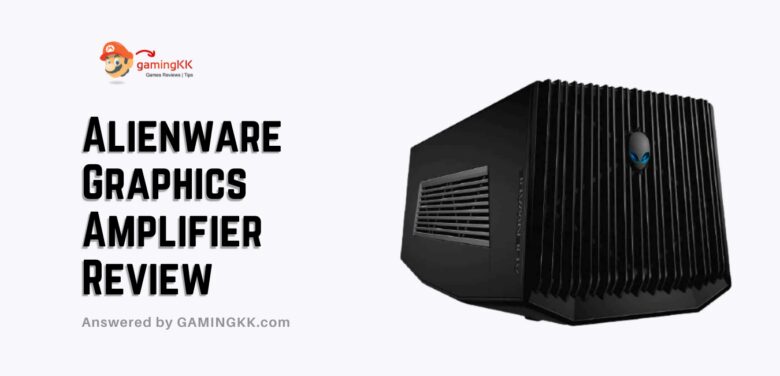Alienware Graphics Amplifier Review

External GPU cases have grown in popularity in recent years, considering their exorbitant costs for what is effectively a tiny machine case.
But the fact is that they are the cheapest way to get close desktop-level graphics output on a laptop, so it’s easy to understand that many people are always willing to pay a premium for an eGPU case.
The Alienware Graphics Amplifier is one of the most common eGPU examples.
As you might know, Alienware is a Dell company well recognized for its high-end gaming laptops, and this case shares many of the design features used in these laptops. Surprisingly, it isn’t just that expensive!
In this post, we’ll look at this external GPU case and its functionality to see if it’s worth purchasing in 2024.
The Style
An Alienware product may be identified from a distance, and the Graphics Amplifier is no exception. This bulky case has a prominent Alienware logo on the front; it is highly detailed and has a sleek black exterior with no pops of color.
Overall, it seems to be very fine, though its only disadvantage is, ironically, a lack of portability. As previously said, it is very heavy and lacks built-in handles, making it difficult to transport. The case itself weighs 7.72 pounds (about 3.5 kg), not including the weight of whatever graphics card you’d install inside, so it’s not exactly small.
Specifications and Compatibility
The Alienware Graphics Amplifier is simple to use. As seen in the picture above, the top cover pops straight up, revealing the internals. Within, there’s a single full-length PCIe slot and ample space for every full-length dual-width graphics card. Furthermore, it comes with a 460-watt power supply, which is more than enough for every modern GPU.
On the back of the box, there are four USB 3.0 ports for connecting and/or charging peripherals such as a monitor, keyboard, microphone, and so on.
Furthermore, while most eGPU instances use Thunderbolt 3 to link to a notebook, the Graphics Amplifier uses a proprietary PCIe connector. Although Alienware says that this technology is quicker than Thunderbolt 3, the main disadvantage is that it severely restricts the usability of the Graphics Amplifier.
The Alienware Graphics Amplifier operates in a straightforward manner: if attached to a compatible laptop, the internal GPU of the laptop is turned off, and the external GPU takes over before it is powered off or removed.
Since the external GPU cannot communicate with the internal GPU through CrossFire or SLI, you cannot gain additional output by matching the internal and external GPU models.
The Graphics Amplifier would also be used for an integrated or external computer screen on a laptop. The latter may be attached to one of the laptop’s display ports or to the external graphics card directly. VR is also allowed, as long as the graphics card and notebook can accommodate it.
Only Alienware computers are supported by the Graphics Amplifier: We have only mentioned that the patented Thunderbolt 3 cable is used for the Graphics Amplifier, and as mentioned on the product page, thus they are supported by just this laptop computer:
- Additionally, the three different models of Alienware are:
- Alienware 17R3-1415, Alienware 15 R1, R2, and R4
- The 17 R3, R4, R5, and R4 alien2 laptops
- Noisy graphics and obnoxious fans
- A true high-performance gaming machine
- Alienware’s newest Area-51 model
- Alienware and X51 R2 are both manufactures of PC laptops that specialize in making gaming computers.
Our Opinions
Overall, the Alienware Graphics Amplifier is a solid external GPU solution, but it does come with its fair share of disadvantages.
We’ve already discussed the two most significant ones: its lack of portability and compatibility with a comparatively limited number of Alienware gaming laptops.
As such, it is not as simple to ship as certain other instances are, and it’s a no-go when it comes to gaming laptops made by other firms.
Furthermore, the Graphics Amplifier might have some possible GPU compatibility problems with newer GPUs, but this is normally easily resolved by driver updates. Alienware says that the Radeon RX and GeForce RTX series are completely supported at the moment, although there might be certain short-term compatibility issues with upcoming GPUs when they are launched — only something to bear in mind.
Aside from that, we have no major concerns regarding the Alienware Graphics Amplifier, but there are some problems that extend to eGPU cases in general, such as high prices and limited capacity in relation to notebook PCs.
But, in the end, an eGPU is the closest thing to PC-level output in a notebook, and this specific eGPU is now cheaper than ever — when it first debuted, it was a whopping $300, but it can now be had for almost half that amount. As a result, if you own one of the Alienware laptops mentioned above and want to offer it a significant performance boost, now may be the time!
If you don’t own an Alienware laptop and are looking for alternatives, take a look at our list of the best external graphics card enclosures of 2024 — you’re sure to find one that meets both your needs and your budget. And if you’re shopping for a graphics card, you may want to check out this post as well.
Originally posted 2021-11-11 12:56:41.